204秋九年级英语u7 A 2a-2d
- 格式:ppt
- 大小:1.56 MB
- 文档页数:15
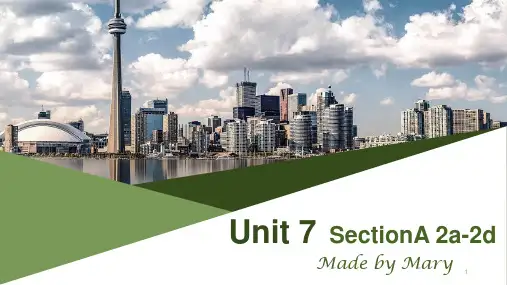
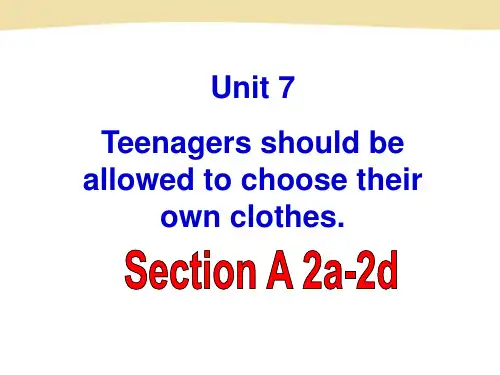
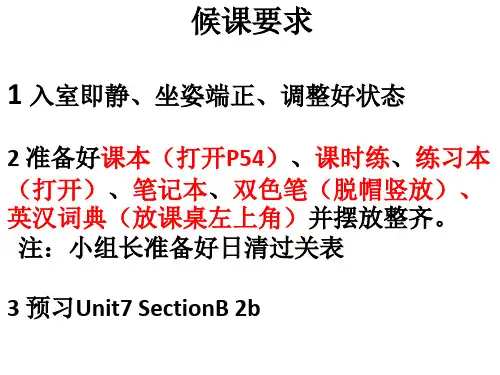
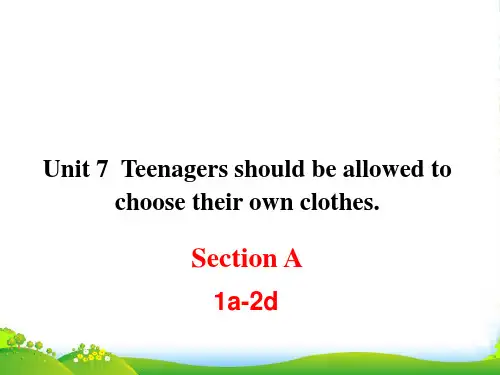

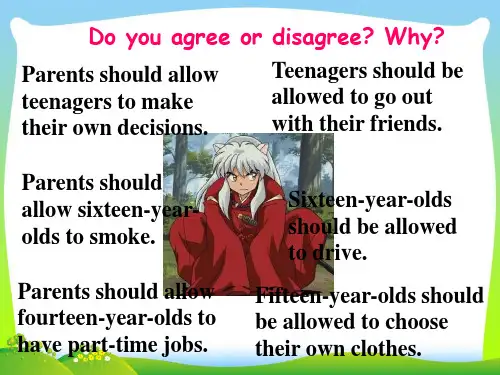

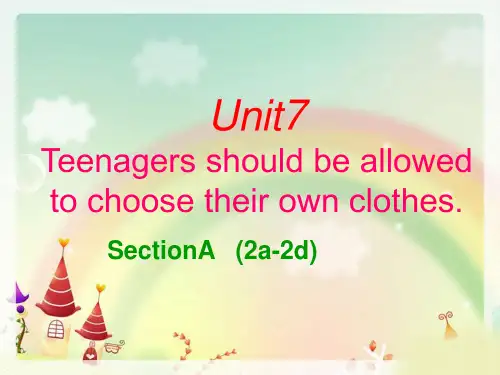
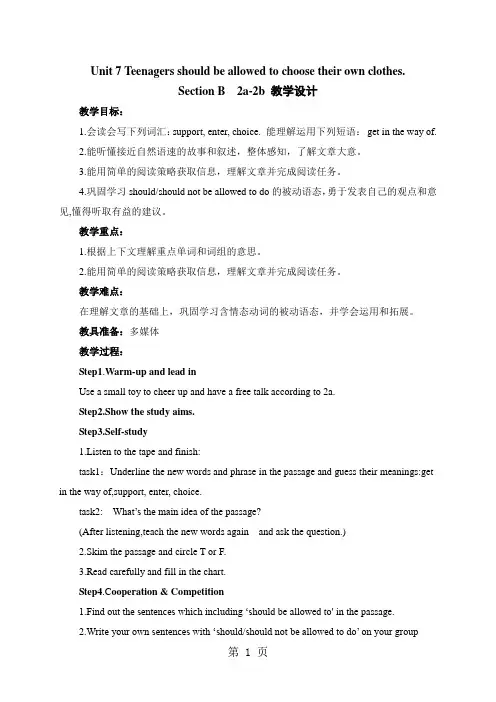
Unit 7 Teenagers should be allowed to choose their own clothes.Section B 2a-2b 教学设计教学目标:1.会读会写下列词汇:support, enter, choice. 能理解运用下列短语:get in the way of.2.能听懂接近自然语速的故事和叙述,整体感知,了解文章大意。
3.能用简单的阅读策略获取信息,理解文章并完成阅读任务。
4.巩固学习should/should not be allowed to do的被动语态,勇于发表自己的观点和意见,懂得听取有益的建议。
教学重点:1.根据上下文理解重点单词和词组的意思。
2.能用简单的阅读策略获取信息,理解文章并完成阅读任务。
教学难点:在理解文章的基础上,巩固学习含情态动词的被动语态,并学会运用和拓展。
教具准备:多媒体教学过程:Step1.Warm-up and lead inUse a small toy to cheer up and have a free talk according to 2a.Step2.Show the study aims.Step3.Self-study1.Listen to the tape and finish:task1:Underline the new words and phrase in the passage and guess their meanings:get in the way of,support, enter, choice.task2:What’s the main idea of the passage?(After listening,teach the new words again and ask the question.)2.Skim the passage and circle T or F.3.Read carefully and fill in the chart.Step4.C ooperation & Competition1.Find out the sentences which including ‘shoul d be allowed to' in the passage.2.Write your own sentences with ‘should/should not be allowed to do’ on your grouppaper ,as many as you can,and have a competition with other groups.Step5.Summary and enjoy a songShould you be allowed to make all the decisions by yourselves?Step6.Practice1.Do a match.2.Choose the right answer.Step7.Homework1.Remember the new words and phrases in this lesson.2.Read the passage aloud after class.3.Finish the exercise book and prepare next period.Step8.Listen to the song “Be What You Wanna Be”.。
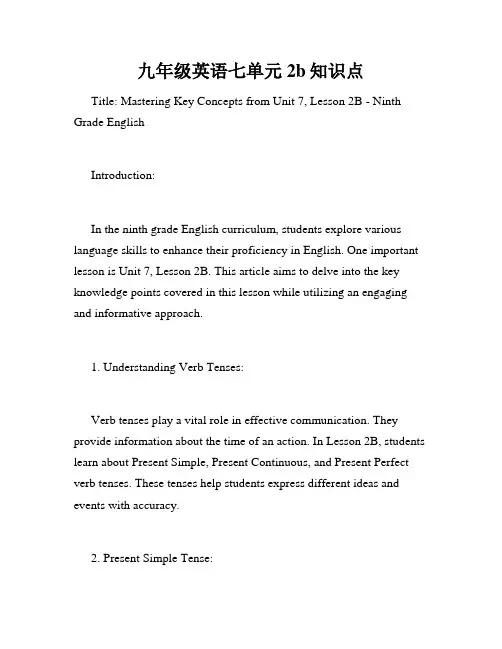
九年级英语七单元2b知识点Title: Mastering Key Concepts from Unit 7, Lesson 2B - Ninth Grade EnglishIntroduction:In the ninth grade English curriculum, students explore various language skills to enhance their proficiency in English. One important lesson is Unit 7, Lesson 2B. This article aims to delve into the key knowledge points covered in this lesson while utilizing an engaging and informative approach.1. Understanding Verb Tenses:Verb tenses play a vital role in effective communication. They provide information about the time of an action. In Lesson 2B, students learn about Present Simple, Present Continuous, and Present Perfect verb tenses. These tenses help students express different ideas and events with accuracy.2. Present Simple Tense:The Present Simple tense is used to describe general truths, habits, routines, and permanent situations. For example, "The sun rises in the east" or "I play tennis every Sunday." It is important to note that in the third person singular form, "s" or "es" is added to the verb (e.g., "He plays football").3. Present Continuous Tense:The Present Continuous tense is utilized to express actions happening at the time of speaking or actions planned for a definite future time. For example, "She is studying for her exam" or "We are going to the mall this evening." The structure of this tense involves the verb "to be" (am, is, are) followed by the present participle of the main verb (-ing form).4. Present Perfect Tense:The Present Perfect tense is used to connect the past and the present. It indicates actions that happened at an indefinite time in the past or have just been completed. For example, "I have visited New York three times" or "She has just finished her homework." The structure of thistense consists of the auxiliary verb "have/has" followed by the past participle of the main verb.5. Differentiating Verb Tenses:Understanding the differences between these verb tenses is crucial for precise communication. While the Present Simple and Present Continuous tenses describe current situations and habits, the Present Perfect tense focuses on past experiences with present relevance.6. Common Mistakes and Tips:Common errors in using verb tenses can hinder effective communication. Students often fall into the trap of using Present Continuous tense instead of Present Simple tense when talking about routines or habits. For example, saying "I am watching TV every day" instead of "I watch TV every day." Awareness of these pitfalls can help students avoid such mistakes.Additionally, in the Present Perfect tense, students sometimes struggle with choosing the correct auxiliary verb (have/has) and past participle form of the main verb. Practicing various exercises andseeking clarification from teachers can aid in overcoming these challenges.Conclusion:Unit 7, Lesson 2B of ninth grade English introduces students to essential verb tenses: Present Simple, Present Continuous, and Present Perfect. A strong grasp of these tenses allows students to express information accurately, convey habits, and describe past experiences with present relevance. By understanding the differences between these verb tenses and avoiding common mistakes, students can enhance their fluency and confidence in English communication.。
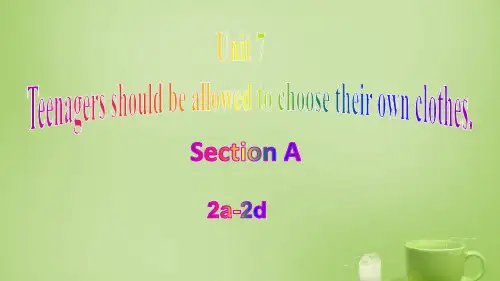
九年级英语第七单元2d知识点在九年级英语的学习中,第七单元是关于名词性从句和主从复合句的学习。
其中,2D知识点是该单元的重要内容,它是关于宾语从句的使用。
在本文中,我们将深入探讨这个知识点,帮助同学们更好地掌握宾语从句的构成和运用。
首先,我们先了解宾语从句的概念。
宾语从句是在句中充当宾语的从句,它通常由连词that, whether, if或由疑问词who, whom, whose, which, what, when, where, how等引导。
宾语从句可以放在主句的谓语动词后面或介词后面。
宾语从句的构成非常灵活,它可以和主句之间保持一致或不一致的语序。
当宾语从句和主句的主语或谓语动词相同时,我们可以将宾语从句改写成不带连词的不定式形式。
例如,原句“Tom said that he would come tomorrow.”可以改写为“Tom said he would come tomorrow.”这样更简洁明了。
当然,在实际运用中,我们要根据具体情况来决定是否改写。
宾语从句的语序和时态与主句有着密切的关系。
当主句是陈述句时,宾语从句常用陈述语序;主句是一般疑问句时,宾语从句采用陈述语序;主句是特殊疑问句时,宾语从句则用特殊疑问句的语序。
在时态上,宾语从句的时态通常根据宾语从句的意思而定,例如,“I don't know if he will come.”中的宾语从句用的是将来时。
在使用宾语从句的时候,我们需要注意几个常见的问题。
首先,当主句是带有情态动词的陈述句时,宾语从句中的谓语动词要使用动词的原形。
例如,“She said that she could swim.”中的宾语从句中的动词“swim”使用了原形。
其次,当宾语从句是一般疑问句时,要将原疑问句的疑问词改为陈述词。
例如,“Do you know where he lives?”中的宾语从句改写为陈述句:“You know where he lives.”最后,有时候我们可以省略宾语从句中的连词,但要保留主句的谓语动词后面的that。
九年级英语7单元2d知识点九年级英语7单元是我们学习的一个重要单元,其中2d知识点是我们需要着重掌握的部分。
本篇文章将对九年级英语7单元2d知识点进行讲解,帮助同学们更好地理解和记忆这些知识点。
首先,我们来了解一下九年级英语7单元的背景。
这一单元主要围绕社交活动展开,涉及了表达感受、描述城市、谈论活动以及了解其他国家和文化等内容。
在这些内容中,2d知识点主要涉及连词的使用和时态的变化。
连词的使用是英语中非常重要的一部分。
对于九年级的同学来说,特别是在写作中,能够正确使用连词可以提高我们的语言表达能力。
在7单元的2d知识点中,我们需要掌握并正确使用的连词有:1. 从属连词:such as, as soon as, before, after, if, unless等。
这些连词用来连接两个从句,在句子中起到连接主从句的作用。
例如:We will go swimming as soon as the rain stops.(只要下雨停了,我们就去游泳。
)2. 并列连词:and, but, or, so, because等。
这些连词用来连接两个独立的句子或短语,在句子中起到连接作用。
例如:I like playing basketball, but I don't like playing football.(我喜欢打篮球,但不喜欢踢足球。
)3. 转折连词:although, despite, however, nevertheless等。
这些连词用来表示转折的关系,在句子中起到连接作用。
例如:Although it was raining, we still went for a walk.(尽管下雨了,我们还是出去散步了。
)除了连词的使用,时态的变化也是九年级英语7单元2d知识点中的重要部分。
时态的正确运用可以帮助我们表达过去、现在和将来的动作和状态。
在这一单元中,我们需要着重掌握以下几个时态的变化:1. 一般现在时:表示经常性的动作或现在的状态。